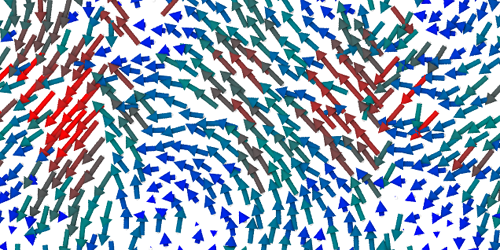Glassy Behavior Depends on Dimension
Glasses exhibit thermal properties that distinguish them from crystalline solids with the same overall composition: typically, glasses have higher heat capacities and lower thermal conductivities. This distinction is especially pronounced at low temperatures because of the different vibrational spectra that glasses and crystalline solids support. In detailed numerical simulations, Lijin Wang, Elijah Flenner, and their colleagues at Colorado State University now determine that the scaling law describing low-frequency vibrational modes in glasses is different in 2D than in 3D and also in 2D glasses of different sizes [1]. The finding shows that, contrary to common assumptions about glasses, behaviors may not be extrapolated across dimensions.
A fundamental difference between the vibrational spectra of crystalline solids and glasses is that in a crystal lattice, the scaling relationship between the number and frequency of vibrational modes follows a long-standing theory of specific heat in a solid, whereas the atomic structure of a glass sustains an excess of low-frequency vibrational modes. That, at least, is the case for 3D systems. To investigate how universal those excess low-frequency modes are, Wang, Flenner, and colleagues performed simulations of large and small 2D glassy solids.
Unexpectedly, they found that in large 2D glassy systems, the number of excess low-frequency vibrational modes scaled according to the square of the frequency—unlike the fourth-power scaling law observed in 3D systems. However, in small 2D glassy systems, the number of excess modes scaled according to the cube of the frequency. The researchers say that future work should examine how the spectra of these excess modes influence the physical properties of 2D and 3D glasses, such as their acoustic attenuation and their stability.
–Rachel Berkowitz
Rachel Berkowitz is a Corresponding Editor for Physics Magazine based in Vancouver, Canada.
References
- L. Wang et al., “Low-frequency excess vibrational modes in two-dimensional glasses,” Phys. Rev. Lett. 127, 248001 (2021).




